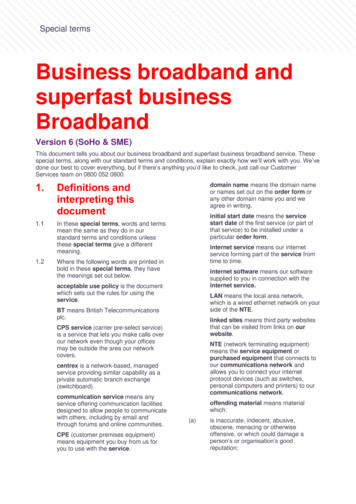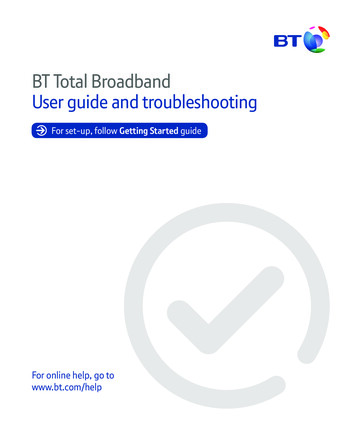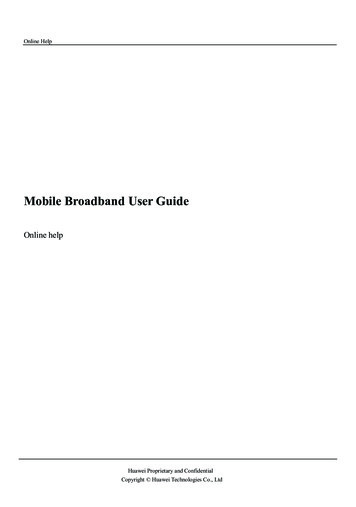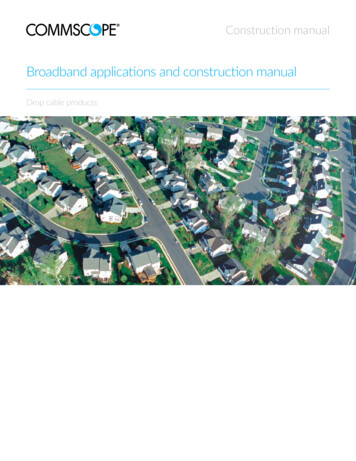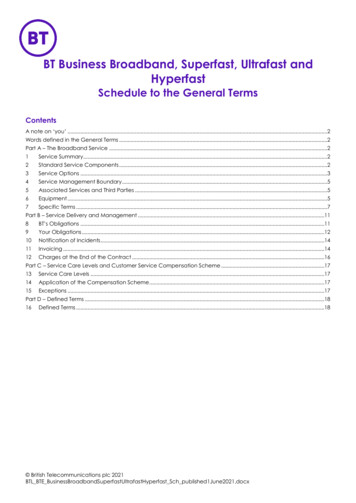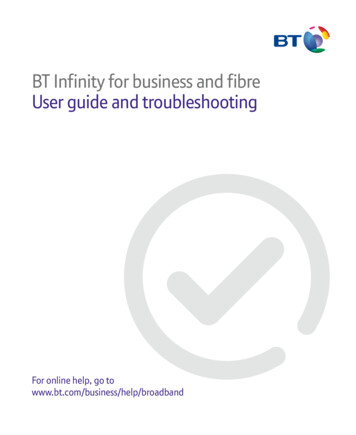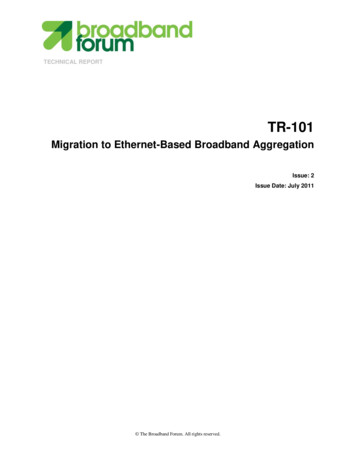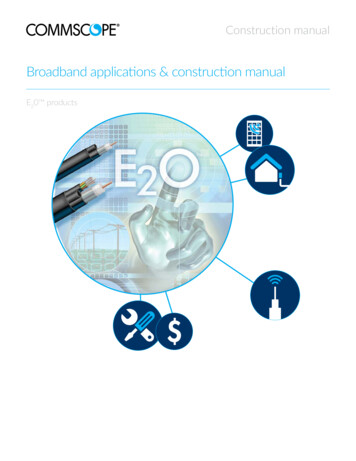
Transcription
Construction manualBroadband applications & construction manualE20 products
allation5Mechanical stress7Pedestal and vault locations8Aerial installations9Preparing microduct9Fiber blowing10Cable entry13Restoration16Appendix172
The confidence of being preparedFor today’s cable multisystem operator (MSO), there are few absolutes. Two things you can count on, however, are: the cost to upgrade youroutside plant will be higher tomorrow than it is today; and, when it’s time to upgrade, speed and efficiency mean dollars saved and servicerevenue.Maintaining an open migration path without jeopardizing your quality of service; being able to bring new services on line with minimum cost,downtime and impact—issues like these are what keep cable operators awake at night.At CommScope, we support many of the largest tier-1 cable MSOs in the world. When it comes to ensuring their outside plant has the built-inflexibility and high performance they need, they trust our E2O solution—and sleep just fine.E2O solutions—build for the futureCommScope’s Electrical to Optical (E2O) product line is a highly customizable solution that combines coaxial cable, optical fiber and/ormicroducts inside a single ruggedized sheath. The flexible design enables you to build in the capacity and space you need to handle futureupgrades with little to no associated installation costs.With E2O, you can: Optimize node splits to allow for future fiber extensions atminimized cost Build the capacity you need for the immediate future, reservingmicroducts for additional fiber that can be blown in at anytime—at a fraction of the cost of replacing your outside plant Create a complete FTTx solution with all coaxial and fibercomponents pre-installed, and bring individual conductors on line asyour channel and bandwidth needs grow. In other words: with E2O,your next outside plant upgrade could be your last for a very longtime.FTTx 32 premise to 1 fiberFiber countPremises served60192072230496307212038401444608In other words: with E2O, your next outside plant upgrade could be your last for a very long time.commscope.com3
What does your migration path look like?These are just a few of the many different configurations available with the E2O family of solutions fromCommScope. E2O gives you the ability to include and combine: P3 , QR , MC2 distribution coaxial cable Distribution and drop fiber-optic cables Microduct for future microfiber blow-in Standard conduit Can be contained by a single jacket or in larger conduit—Cable in conduit (CIC)The connectivity professionals at CommScope will work with you to customize a solution that fits your needs and budget.Microfiber and microduct pairingSuccessful installations begin with pairing the appropriate microfiber and microduct. The optimum fill range for blowing is 50 to 70 percent.Anything less than 30 percent could begin to cause issues with gathering or looping of the fiber in the duct. Anything greater than 70 percentcould restrict the airflow, lowering placement efficiency and distance as well as making it around bends more difficult.MicroductMicrofiberSizeOD, in.ID, in.MF, countOD, in.OD, mm% 0.3942–600.225.5931commscope.com4
E2O CIC general installation practicesPay-offWhen installing E2O CIC, pay off the reel from underneath and in as direct a line as possible to the trench or bore to avoid unnecessarybending of the conduit or rubbing of the conduit against the reel flange. When feeding E2O CIC into a manhole, pay-off should occur from thetop of the reel—with the manhole on the side opposite of the direction of pull.Cable/microduct/tone (locate) wire withdrawalE2O CIC conduit is slightly longer than the cables/microducts/tone wire it contains. Allow an average of1.5 percent of cable/microduct withdrawal back toward the reel during unspooling (example: 2000 feet of conduit will yield 1970 feet ofcable). The withdrawal will be greater as you approach the end of the reel.Cut the restraintPrior to installing E2O CIC, remove the conduit end cap and cut the cable restraint. This relaxes the cable and transfers all of the pulling tensionto the conduit.Keep cappedTo maintain conduit integrity, make sure both ends are capped during the installation. Foreign objects and debris entering an uncapped conduitcan result in damage of installed cables and may cause blockage—making future cable replacements difficult.Attaching to E2O CICSome installation methods require an attachment to the E2O CIC conduit to facilitate pulling. The following tools work particularly well for this:the “basket pulling grip,” the “thread in eye”, and expansion eye.Basket pulling gripWhen using the basket pulling grip it is important to remember: the tool isdesigned to compress and grip the surface of the object it is pulling. NOTE:Basket pulling grips should not be used on conduit sizes larger than 1¼inches.Inner duct pulling eye with swivelUnlike cable, conduit has an extremely rigid surface that does not allowfor a good grip. In order to achieve a solid grip on conduit, a more pliablesurface—such as duct tape or electrical tape—needs to be applied.Apply bands of tape at 5-inch (2-cm) intervals from the conduit cap backto the point where the basket pulling grip will end. The tape only has to beapplied in single-width bands but must be at least 1/16-inch (.03-cm) thick.Place the grip over the capped conduit and bands, then pull the grip totighten its grasp on the conduit. To help hold the grip in place, tape needs to be applied to the conduit and then wrapped onto the end of thegrip. Do not extend the tape beyond the first three inches of the end of the grip.The thread-in eye provides a pulling attachment that does not produce an increase in the outer diameter of the conduit. This is an addedbenefit not found in other devices. The installation of this device simply requires it to be screwed into the end of the conduit. The device hasan eyehole for the attachment of a winch line or attachment to a plow blade.Conduit pulling eye with swivelThis tool should be considered when pulling into a directional bore. All benefits of theinner duct pulling eye apply.Note: This tool is not recommended for pulling inner duct.commscope.com5
Cutting E2O CICSeveral tools have been found useful for the purpose of cutting E2O CIC conduit. While selection of the tools is usually defined by the user’spreference, there are some application restrictions based on tool designs.To cut E2O CIC, open the tool and place it around the conduit at the point where the cut is to be made. While applying pressure to the conduitwith the cutting edge, begin rotating the tool around the conduit—increasing pressure as you go and being careful not to cut or score the cableand microducts inside. To provide an even cut, it is often helpful to rotate the tool in opposite directions with each full pass around the conduit.Note: This is the preferred method for cutting conduit with pre-installed cable and microducts.When a tone (locate) wire is present in the E2O CIC, it is important to restrain the wire prior to cutting it to prevent the wire from withdrawinginto the conduit.The best method to accomplish this is to apply a pair of vice grips on both sides of where the cut will be made.point where the cut will be madeOnce cut, the tone wire can be folded back over the edge of the conduit and secured with tape or a tie-wrap.secure tone wire with tape or tie-wrapOnly secure the ends of the tone wire on E2O CIC that has been placed in the ground.DO NOT secure the end of the tone wire on the end of E2O CIC that is still on the reel—it will cause too much tension on the wire duringinstallation and will result in damage to the product as well as severe withdrawal at the next cut.commscope.com6
Bending E2O CIC (underground)E2O CIC can be easily shaped by rolling a bend into it. Take 10–12 feet (3–3.5 meters) of conduit and pull the free end of it toward you—forming a “horizontal U.” Push into the bend lightly and roll the entire radius of the conduit forward. DO NOT bend the conduit any further if itbegins to show signs of ovality, i.e. begins to bulge.DO NOT press down on the conduit with your foot as you bend it.Bending radius (all)Conduit is often routed around corners during placement and pullingtension must be increased to apply adequate force to the conduit tobend it around the corner.CommScope’s specified minimum bend radius is the static (unloaded)bending radius of the conduit. This is the minimum radius to which theconduit can be bent without mechanically degrading the performanceof the conduit.The bending radius of conduit and cables during the constructionprocess is controlled by construction techniques and equipment. Usethe largest bend radius possible to help reduce overall pulling tension.SizeMinimumbend radius(lbs.)Maximumpullingtension (lbs.)2" SDR13.5262,5801.5" SDR13.5201,45516/13mm821012.7/10mm6120WARNING: Exceeding the minimum bending radius can result in permanently ovalizing the conduit, which may restrict cable installations.Exceeding the minimum bending radius of cables can damage the electrical or optical performance.Regardless of the installation method, mechanical stress is of great concern during conduit and cable placement.Exceeding the maximum allowable pulling tension can damage conduit and cable. Pulling tensions for E2O CIC conduits can be found inspecifications at the end of this manual.Pulling tensionThere are three general causes that affect pulling tension during the installation of conduit or cable: conduit or cable weight, sidewall pressure,and tail loading. Weight of the conduit or cable can be directly associated to pulling tension as a factor of force required to move an object weighing anumber of pounds over a given distance. The more the conduit or cable weighs, the greater the pulling tension. The longer the distance, thegreater the pulling tension. Sidewall pressure or loading is the radial force exerted on a conduit or cable when pulled around a bend or sheave. Excessive sidewallpressure can crush the conduit or the cable. Tail loading is the tension on the conduit or cable caused by the mass of the conduit on the reel and reel brakes.commscope.com7
Tail loading is controlled by two methods. It can be reduced using minimal braking during the pay-off of the conduit from the reel at times.Generally, no braking is preferred. Rotating the reel in the direction of pay-off can also minimize tail loading.WARNING: Exceeding the maximum pulling tension can result in the conduit drawing down in size. While it may recover after a period ofresting, the mechanical properties of the conduit are permanently degraded, which may reduce the life expectancy of the conduit. Exceedingthe maximum pulling tension of cables can damage the electrical or optical performance.Break-away swivels should be placed on the conduit to ensure that the maximum allowable tension for that specific conduit or cable type isnot exceeded. The swivel is placed between the conduit/cable pull member and pulling grip.A break-away swivel is required for each conduit or cable.Pedestal and vault locationsManaging E2O at pedestal and vault locations is simple. Generally, it is recommended to leave a minimum of five feet of tail on each E2O CIC ata pedestal or vault location. The preferences to terminate all cable and microducts—or to pass through some or all cable and microducts—areboth acceptable practices. It is simply a matter of how a network engineer wants to deploy the product.These are a few examples:Terminating all cable and microductsHere, the entire E2O CIC is simply cut off at the vault or pedestal to the desired length. The run may include a single or multiple outputs fromthe location, which also consist of E2O CIC cut end(s).Terminating coaxial cable and passing through microductsIn this application, the coaxial cable is being cut to feed an RF device while the microducts are passing through this location to anotherpedestal or vault downstream. There are two methods to accomplish this.The first method is to simply bring the desired length of a cut end of E2O CIC for both the input and output of this location and then join themicroducts using the proper coupling procedure.The second method is to overpull the E2O CIC and create a loop of the length the cable tails need to be. The next step is to cut away the outerconduit, using a conduit slitter, to expose the cable and microducts. The cable can now be cut and the microducts are left complete and routedappropriately in the pedestal or vault to prevent kinking or damage.Passing through all cable and microductsThis application may be used where there is a need to have future accessto the microducts for fiber access and there is no immediate planned useof the coaxial cable. This also leaves enough coaxial cable available foruse in powering a future optical receiver/node at this location.The procedure to accomplish this is to overpull the E2O CIC and create aloop of the length the cable and microducts are to be. Then, cut away theouter conduit, using a conduit slitter, to expose the cable and microducts.The cable and microducts need to be carefully routed in the pedestal orvault to store the excess length without kinking or damaging them.commscope.comHow much cable and microduct there shouldbe at each vault and pedestal should bedetermined by a system engineeror construction head.8
Aerial installationsBoth E2O CIC and the microducts themselves may be lashed to a bare strand. Microducts may beoverlashed to existing strand and cables.DO NOT lash microfiber. The microfiber cannot withstand lashing.2 feetWhen transitioning from underground with E2O CIC, it is recommended that the E2O CIC is runvertically up the pole to provide protection for the microducts and cable(s). The outer conduitshould stop about two feet below the strand attachment height to allow a good radius sweep ofthe microducts and cable(s) from the riser to the strand.The only place the microfiber should be exposed is at a splice closure. The microfiber should becoiled to slightly larger than the minimum bend (minimum bend plus 1/2 inch) radius of the cablethat is being used. The coil should be positioned so it nearly touches both the microduct and thesplice closure. Using a polymer strapping system such as the Allied Bolt ABstrap lashing strapsystem is recommended.Microduct end preparationProperly preparing the ends of the microducts is critical to successfully blowing fiber. The first stepis to ensure a clean, square end cut. The use of microduct cutter GMP 89565 is recommended.Next, the ends at every set-up location and every coupler location must be cleanly beveled to eliminate a potential hang-up point for the fiberprior to installing the fiber.The recommended method for beveling the microduct is to use a 5/8-inch countersink bit, such as the Ryobi SpeedLoad Plus 5/8-inchhigh-speed steel countersink model #A10CS08 on a hand bit driver. If possible, point the microduct end toward the ground to prevent thewaste material from going into the duct.The microduct beveled end should be smooth and clear of burrs or loose material.commscope.com9
Capping and coupling the microductOnce preparation of each end is completed, it is recommended that the microducts either be capped orcoupled. This will prevent particles and moisture from accumulating in the microduct, which can impedethe installation of the fiber. Caps will need to be removed prior to blowing in fiber.The caps and coupler simply push on the microduct until fully seated, which can be observed throughthe transparent portion.Caps and couplers can be removed and reinstalled by simply pushing the rear cam ring forward whileremoving the cap or coupler.Here is a list of the corresponding cap and coupler part numbers:Straight coupler 16/13mmBCA16MUC16MEnd cap 16/13mmBCA16MCAPStraight coupler 12.7/10mmBCA8UC8End cap 12.7/10mmBCA8CAPPreparing the microduct for fiber blowingPrior to blowing in the fiber, the microduct should be cleaned and lubricated.Clean and dry the tubing by blowing a tight-fitting foam sponge throughthe microduct with high pressure. If excess water or dirt comes from themicroduct, repeat the process. Trapped water can block the air flow. Therecommended size of the foam sponge is 24mm (0.945 inch) diameter x35mm (1.378 inch) length.Tech tip: Number the foam sponges to keep track of them. If one of thembecomes lodged in the microduct it will prevent the fiber from blowingthrough it.Squeeze the recommended amount (see table) of Polywater Prelube 5000 into the duct. The lubricant is spread by blowing a foam carrier orsponge through the microduct as many times as necessary to avoid puddling at the front of the duct.Microduct size (OD/ID)Lube quantity per 1,000 feet:volume requiredLube quantity per 1,000 feet:fill length of tube16/13 mm0.30 fl. oz. (9 ml)3 inches (8 cm)12.7/10 mm0.25 fl. oz. (7 ml)4 inches (10 cm)10/8 mm0.20 fl. oz. (6 ml)5 inches (12 cm)Fiber blowing equipmentThere are many types of equipment available in the market for blowing fiber. Since it would bedifficult to detail all in this manual, the GMP Airstream 89300 will be used for the purpose of thisdiscussion on how to set up and blow the microfiber into the microduct.NOTE: It is important to refer to the manufacturer’s instructions on use of the specific equipmentbeing used for your installation.At minimum, in addition to the fiber blowing equipment, an air compressor is required. Whenconsidering an air compressor, air pressure—referred to in bars—is more critical than volume of air,which is typically referred to in cubic feet per minute (CFM).commscope.com10
15 bars is the ideal and maximum pressure that should be used, while 10 bars of pressure is theminimum.With 15 bars of pressure, the air flow should be 35 CFM minimum and 180 CFM maximum. At 10 barsof pressure, however, the ideal and maximum air flow should be 180 CFM.While not required, it is strongly recommended that a compressor aftercooler with a water separatorbe used on the supply line to the fiber blowing equipment. An air compressor running continuouslyfor 24 hours at 75ºF and 75 percent humidity will produce about 18 gallons of water per day. Acompressor aftercooler with a water separator can remove about two-thirds of the moisture and lowerthe compressed air temperature to within 15 F of ambient air temperature. The GMP compressoraftercooler #89009 is a suitable unit.Since water and high temperatures in the microduct work against the process of blowing fiber, it is important to eliminate it. Doing so willincrease the efficiency of blowing fiber, which will make it possible to blow through longer and more difficult runs.Setting up for fiber blowingPosition the machine in line with the route of the duct. Position the cable reel or figure-eighted cable behind the machine and in line with themachine.Cable reel / figure-eighted cableAirstreamMicroduct RouteIt is possible to pay the fiber directly off the reel, but, due to the speed at which the cable pushes the fiber, two people may be required toassist the pay-off. Therefore, it is recommended that the length of cable that will be blown in is taken off the reel first.Managing the cable when it is off the reel can be achieved using one of several methods. The methods selected should be based upon severalfactors: The amount of space available to the lay the cable out How clear of obstacles, debris, dirt/mud, and traffic the area is How many experienced people there are to support the feedingof the cableThe methods are to: Figure-eight the cable--Use a tarp in areas of dirt/mud, leaves, deep grass, andother debris--Figure-eight must be carefully watched to prevententanglements, which are more common with microfiberbecause of their flexibility Figure-S the cable--Figure-eightFigure-SCable fleeterUse this in areas where there is a lot of space with very little or no debris, no obstacles, and no traffic Cable fleeter--Optimum for limited space and high-traffic areas--Ideal for small crews as it can be monitored by the individual operating the blowing equipmentcommscope.com11
Ensure the machine is fitted with the appropriate guidesand collets to suit the cable being installed and tubes intowhich the cable is to be installed. For assistance, refer tothe table in the appendix of this manual.Tech tip: In dry air conditions, it is recommendedto ground the machine using the ground lug toprevent static charges.1. Loosen the knob on the drive close assembly and slidethe assembly to the far right, opening the drive belts.2. Loosen the knob on the air box and open the air box.3. Loosen the knob on the tube collet and clamp assemblyand open the assembly.4. Slide the correct size O-ring over the end of the tube.Fit the tube into the end of the air box housing so itprotrudes approximately halfway into the housing. Position the O-ring so it sits against the seal face, as shown.5. Once the tube has been positioned, the tube clamp may be closed, the swing bolt swung down and the thumb nut tightened. The tube isnow secure.6. Insert the cable into the machine by feeding the cable through the first cable guide assembly, through the open drive belts, and through thesecond cable guide assembly, through the appropriate sized cable seal, and then into the microduct about one foot.7. While holding the cable in place, slide the drive close assembly to the left. Apply enough force for the belts to grip the cable firmly and thentighten the knob on the drive close assembly.8. Close the air box and tighten the knob to achieve a tight seal for the air box.Tech tip: Cut a slit into a clean, dry sponge and lay the cable into the slit at the entry point to the blowing equipment. This will help reduce the amountof debris entering the machine and microduct during the blowing process.To begin the fiber installation, set the torque at 50 to 60 percent, set thespeed at around 30 percent, and set the machine to forward. The high/low torque selector should be set on low for the 2- to 60-ct fiber (5@1)and the 62- to 72-ct fiber (6@1), and set to high for all other cables.The machine may now be started with the air off. Slowly increase thespeed. The cable should be installed at a rate of 200–220 feet perminute. Installing at a faster rate can create too much friction, whichmay result in permanent damage and/or installation difficulties.Once 100–300 feet of cable is installed, the air should be turned on.Slowly opening the air valve will prevent the initial airflow and pressurefrom working against the cable. It should take about 15–20 seconds tofully open the air valve.Tech tip: Do not stop the blowing operation until the appropriate amount of fiber has been delivered to the desired location—unless there isa problem. Once the fiber stops, it is harder for the machine to start moving the fiber again, particularly as the distance increases or the runsbecome more complex.commscope.com12
Cable entryMicrofiber mid-sheath entryMidsheath entry of microfiber cable is performed using a jacket slitter and buffer slitter while following the simple process that is outlined here.Identify where the buffer tubes, winding switchback is located nearest to the center point of where the mid-sheath entry is going to be. Thispoint is now the center of the mid-sheath entry. Mark this point by placing a band of tape around it.The next step is to identify the choke points, where the mid-sheath entry begins and ends. To do this, measure from the center point in bothdirections half of the length that is going to being placed in the enclosure. Mark each choke point with a band of tape around it.As an example:When using the CommScope BOS-ENC-BG-2000 below ground splice closure, the recommended buffer tube length is 68". Each choke pointwould be measured 34" from the center point.Remove the tape from the center point to allow the jacket slitter to pass unimpeded from one choke point to the other choke point.Using one of these jacket slitters, open the jacket to each choke point. It is important to read the operating instructions provided with the toolfor proper adjustment and operation.Miller (Ripley ) Toolswww.ripley-tools.com 800-528-8665ACS2 Armored Cable SlitterPart No.: 37897For Up to 144ct microfiberMiller (Ripley ) Toolswww.ripley-tools.com 800-528-8665400 Series SlitterFor up to 72ct microfiberPart Number: 80835-0125.6–6.0mm Dark Blue Guide 400 Guide Block SetFor 98-120ct microfiberPart Number: 80835-0138.1–8.5mm Orange Guide 400 Guide Block SetFor 144ct microfiberPart Number: TBD9.1mm Guide 400 Guide Block SetJonard Industrieswww.jonard.com 914-793-0700CSR-1575For up to 144ct microfiberTech tip: leave the rip-cord intact, forming a small coil, and tape the coil to keep it together; that way, if more length is needed, the rip-cord isalready available.Remove the cable core from the jacket and trim the jacket at the choke points.Working at one choke point, cut each aramid yarn binder being careful not to loosen the bind beyond the area where the cutting is being done.Slide the binders just enough to create a space where a band of tape can be wrapped around the cable’s core. Now continue sliding thebinders until the first switchback is exposed. Being careful to keep the buffer tubes in their proper switchback positions, place a band of tapearound the core of the cable. It is helpful to wrap the tape in the direction of the switchback. This process is continued until the binder reachesthe other choke point. When complete, there should be a small tape wrap located at each switchback location.commscope.com13
Carefully cut away all the binderPartially remove the band of tape from the center switchback, thenslightly untwist the core just enough to access the central strengthmember and cut the central strength member. Carefully pull out eachpiece of central strength member from the core. It is important tokeep the core from untwisting while doing this, maintaining the core’sintegrity.At one choke point, gently and slightly untwist the core just enoughto access the central strength member and cut the central strengthmember to the required trim dimension for the enclosure based onthe closure manufacturer’s recommendations.As an example:When using the CommScope BOS-ENC-BG-2000 below groundsplice closure, the recommended central strength member length is0.625".Repeat this process at the opposite choke point.Next select the buffer tube that is to be accessed in this closure andstart to untwist it from the core, making sure to keep the remainingbuffer tubes in their wrapped position. This process starts at thecenter switchback, and requires that the tape be loosened. Separatethe buffer tube from the core, and replace the band of tape aroundthe switchback.Continue separating the buffer tube from the core until the nextswitchbacks are reached. At only one switchback, partially removethe band of tape and separate the buffer tube past it; then, replacethe band of tape around the core, keeping the core as it was. Repeatthis process for the other switchback. This process is continued untilthe choke points are reached.commscope.com14
Now the cable core can be folded into a coil that will be placed ineither the tray or the slack storage basket.To perform a midsheath entry on the buffer tube, use one of thesebuffer tube slitters. It is important to read the operating instructionsprovided with the tool for proper adjustment and operation.The fiber may now be stored in the splice tray.Miller (Ripley ) Toolswww.ripley-tools.com 800-528-8665400 Series SlitterFor 1.6mm buffer tubePart No.: 80950 400-1.8mmThe buffer tube that is to be accessed for splicing can now be slitusing a mid-sheath buffer tube slitter. Cut away the buffer tube fromthe fibers according to be required trim dimension for the enclosurebased on the closure manufacturer’s recommendations.Miller (Ripley ) Toolswww.ripley-tools.com 800-528-8665MSAT Micro: Part No.: 81460MSAT Micro insert 1.6 mm Part No.: 81516Jonard Industrieswww.jonard.com914-793-0700Mid Span Slitter MS-15commscope.com15
Restoration of E2O CIC, microducts and microfiberAs with restoring any conduit product, there are many ways to restore E2O CIC—from setting a new vault/pedestal at the point of damage toreplacing the span from vault/pedestal to vault/pedestal.One advantage E2O CIC offers over traditional restoration is that the microduct can be quickly repaired, the damaged cable blown/pulled out,and a new one blown in over significant distances in a very short amount of time.Should the restoration be done as a repair in place instead of setting a new vault/pedestal, it is recommended that the outer conduit berepaired as well as the microducts. This will provide the necessary protection for the microducts so fiber can be blown into them. The samepreviously given techniques used for coupling the microducts should be used.The outer conduit can be repaired using a split duct repair solution available in the market. Or a larger conduit can be split in half in the field,banded together with zip ties and epoxy-sealed around the joints to prevent water and mud migration into the conduit.commscope.com16
Appendix—Specification and packagingMICROFIBER PHYSICAL SPECIFICATIONSFibercountCableouterdiameterCatalog numberMinimum bend radiusMax. tensile windowMax. verticalriseSubunitsWeightLoadedUnloadedShort termLong term8.2 cm;3.2 in.5.5 cm;2.1 in.324 N;73 lbs.97.2 N;22 lbs.488 m;1,600 ft.2–60B-XXX-LN-XYFZZNS/16G15.5 mm;0.21 in520 kg/km;14 lbs./kft62–72B-XXX-LN-XYFZZNS/16G16.0 mm;0.23 in626 kg/km;17 lbs./kft8.9 cm;3.5 in.6.8 cm;2.7 in.600 N;135 lbs.1
O CIC Several tools have been found useful for the purpose of cutting E 2 O CIC conduit. While selection of the tools is usually defined by the user's preference, there are some application restrictions based on tool designs. To cut E 2 O CIC, open the tool and place it around the conduit at the point where the cut is to be made.
